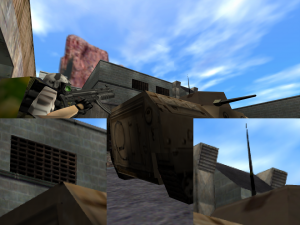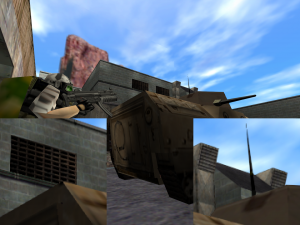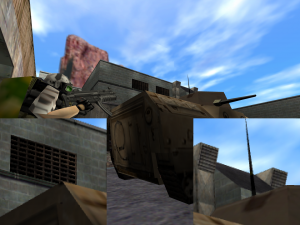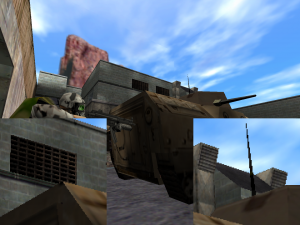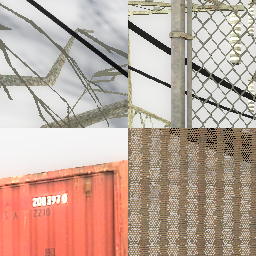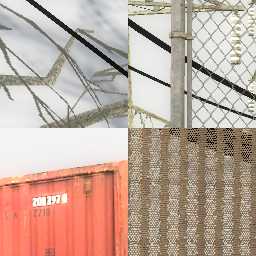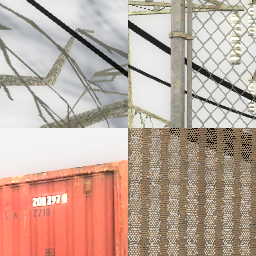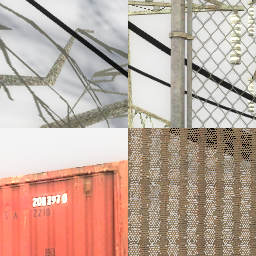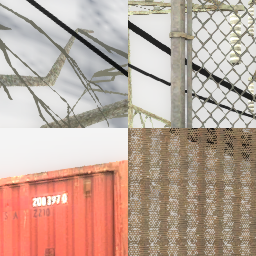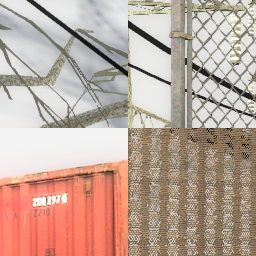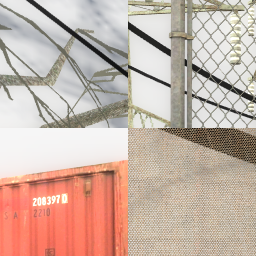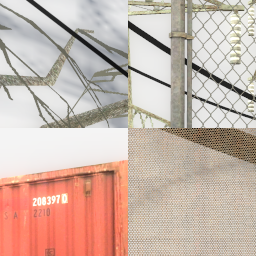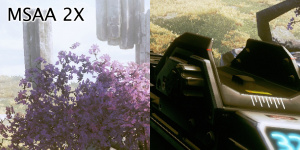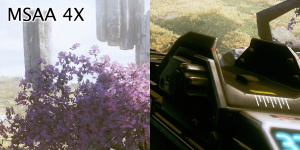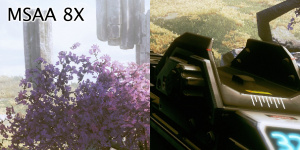Anti-aliasing
As a courtesy, please do not edit this while this message is displayed.
If this page has not been edited for at least several hours to a few days, please remove this template. This message is intended to help reduce edit conflicts; please remove it between editing sessions to allow others to edit the page.
The person who added this notice will be listed in its edit history should you wish to contact them.
This page either contains information that is only partially or incorrectly translated, or there isn't a translation yet.
If this page cannot be translated for some reason, or is left untranslated for an extended period of time after this notice is posted, the page should be requested to be deleted.
Also, please make sure the article complies with the alternate languages guide.
Anti-aliasing (AA) is a graphics technique extensively employed in Valve video games, such as those in the 半衰期 series, as well as in other software applications developed by Valve, including ![]() Steam and
Steam and ![]() 起源电影制作器, etc. This technique is utilized to enhance the visual quality and reduce the jagged edges, or jaggies, that can appear in computer-generated imagery.
起源电影制作器, etc. This technique is utilized to enhance the visual quality and reduce the jagged edges, or jaggies, that can appear in computer-generated imagery.
Computer monitors are essentially a large grid of squares that can be set to any color or brightness. As such, it is impossible to draw a perfectly straight line, because no matter how many squares there are, it will never be able to make a perfectly smooth diagonal. This creates a stair-step pattern that gets increasingly noticeable the lower the resolution is, which is often referred to in the video game world as "Aliasing". ![]() Spatial anti-aliasing, often referred to simply as anti-aliasing, is designed to combat the problems of aliasing. In simple terms, anti-aliasing is designed to smooth out that stair-step pattern in images and make them look less pixelated, while not changing the resolution of the final image.
Spatial anti-aliasing, often referred to simply as anti-aliasing, is designed to combat the problems of aliasing. In simple terms, anti-aliasing is designed to smooth out that stair-step pattern in images and make them look less pixelated, while not changing the resolution of the final image.
While anti-aliasing is available on PC, it was often not supported on consoles until the release of 传送门2 (which uses MLAA on PlayStation 3), as traditional methods like MSAA are very expensive, compared to post-processing methods like FXAA/TAA/MLAA used in later games. In all 起源2007 games and above on Xbox 360, it uses software AA, which is not as effective as newer post-processing methods.
Overview
Traditional methods
- Restore missing details and looks sharper compared to post-processing methods
- More expensive than post-processing methods (also SSAA is more demanding than MSAA, while produce better result)
- Most newer games (that uses deferred renderer) does not support these methods
- MSAA only: Does not apply anti-aliasing to transparent textures without alpha to coverage
SSAA
![]() SuperSampling Anti-Aliasing, also known as Full Scene Anti-Aliasing (FSAA) in some games and often interchangeable with the term downscaling.
SuperSampling Anti-Aliasing, also known as Full Scene Anti-Aliasing (FSAA) in some games and often interchangeable with the term downscaling.
- Technically when implemented correctly, these do differ in that downscaling applies to an entire frame buffer – 2D and 3D Elements, while SSAA/MSAA are techniques only applied internally to 3D elements. In some implementations this can result in a lesser performance impact and better compatibility.
Compared to MSAA, SSAA/FSAA produces the same result as MSAA, but completely reduced stair-step pattern in alpha textures, and makes transparent letters (on the container prop) less blurry. Additionally, ReShade depth buffer detection works with SSAA. However, despite it's very high-quality results, SSAA is very expensive when it comes to performance compared to MSAA, and SSAA is not available as an option in Source by default, but can be enabled below:
On NVIDIA graphics cards, it's implemented as OGSSAA (Ordered Grid Supersample Anti-Aliasing), and can only be enabled through third-party applications such as ![]() Nvidia Profile Inspector, using the following modes: 2x1, 1x2, 2x2, 3x3, 4x4. OGSSAA also only supports Direct3D.
Nvidia Profile Inspector, using the following modes: 2x1, 1x2, 2x2, 3x3, 4x4. OGSSAA also only supports Direct3D.
Downscaling
Downscaling or downsampling is a brute-force method for AA, which applies SSAA to both 2D (such as HUD and UI) and 3D elements by running the game at a higher resolution. It can be enabled on graphics card control panel as NVIDIA DSR or AMD VSR. Unlike SSAA, downscaling will produce slightly blurrier results and does not get rid of the shimmering effect on transparent textures/objects.
Another downside to downscaling is that many older games' UI (such as VGUI) will become smaller at higher resolutions. However, recently 半衰期2 and 半衰期2:死亡竞赛 (both since 20th anniversary), and aswell as 军团要塞2 has been updated to allow VGUI to scale properly on higher resolution, while all games since 求生之路 properly scales UI at 4K or higher (except close captioning which does not scales in 求生之路, but does on 求生之路2 and newer titles).
MSAA
![]() MultiSample Anti-Aliasing (MSAA) was the gaming industry standard of anti-aliasing (prior to the TAA gradually replacing MSAA in mid-late 2010s as games transitioned from forward rendering to deferred rendering), and as such is the only anti-aliasing available (alongside CSAA on NVIDIA cards prior to Maxwell) in all
MultiSample Anti-Aliasing (MSAA) was the gaming industry standard of anti-aliasing (prior to the TAA gradually replacing MSAA in mid-late 2010s as games transitioned from forward rendering to deferred rendering), and as such is the only anti-aliasing available (alongside CSAA on NVIDIA cards prior to Maxwell) in all ![]() 起源 games before
起源 games before ![]() 反恐精英:全球攻势, and later available in
反恐精英:全球攻势, and later available in ![]() 金源 in 2013, with only MSAA 4x being available, which is enabled by default. In
金源 in 2013, with only MSAA 4x being available, which is enabled by default. In ![]() 金源, the anti-aliasing can be disabled by starting with the
金源, the anti-aliasing can be disabled by starting with the -nomsaa launch option. Essentially, if a polygon is crossing a multisample point, or subpixel, it detects how many of its neighboring points are also being intersected, then takes the color of that polygon and adds it over the existing image to create a slightly smother line. This creates a smoother line, but does not completely remove the stair-step pattern (especially on alpha textures that don't use alpha to coverage) without combining FXAA/SMAA/other post-FX AA methods with MSAA, plus games that use deferred rendering and MSAA may not work properly and can cause various other issues. This is usually sufficient for most users, however.
All GoldSrc, Source and Source 2 games contain 3 different settings of MSAA, which include:
- 2x
- 4x - Default level in post-SteamPipe
 金源 (can be enhanced in GPU control panels), aswell default on
金源 (can be enhanced in GPU control panels), aswell default on  post-20th anniversary
post-20th anniversary - 8x - Very expensive on older/low-end hardware. Introduced in Source 2006. You can enable 8x MSAA in Source 2004 by using the
mat_antialias 8console command, or force it through driver settings.[1]
What this does is add more subpixels to a specified location and increases the accuracy of the multisampling, at the cost of performance. Some alternative anti-aliasing methods such as the post-processing one will be less demanding compared to MSAA or other methods.
SGSSAA (and transparency AA)
(仅存在于 ![]() 之中) SGSSAA, short for Sparse Grid Super-Sampling Anti-Aliasing is a improved version of SSAA (or OGSSAA), using MSAA and TrSSAA (for transparent textures without alpha to coverage), to apply anti-aliasing to the image. Enabling this method requires third-party application such as NVIDIA Profile Inspector, plus change the "Antialiasing - Compatibility (DX9)" flag and LOD bias to allow SGSSAA to work, produce good results and makes distant texture looks significantly sharper (compared to NVIDIA DSR), it also produces more detail than OGSSAA (or regular SSAA), and transparent textures will look better than using alpha to coverage (which creates noticeable dithering when looking closer).
之中) SGSSAA, short for Sparse Grid Super-Sampling Anti-Aliasing is a improved version of SSAA (or OGSSAA), using MSAA and TrSSAA (for transparent textures without alpha to coverage), to apply anti-aliasing to the image. Enabling this method requires third-party application such as NVIDIA Profile Inspector, plus change the "Antialiasing - Compatibility (DX9)" flag and LOD bias to allow SGSSAA to work, produce good results and makes distant texture looks significantly sharper (compared to NVIDIA DSR), it also produces more detail than OGSSAA (or regular SSAA), and transparent textures will look better than using alpha to coverage (which creates noticeable dithering when looking closer).
mat_alphacoverage 0) to avoid some transparent textures shimmering due to SGSSAA conflicting with alpha to coverage.cstrike_win64.exe, dod_win64.exe, etc.), so you will need to add the new executable name into driver profile first (in Nvidia Profile Inspector), before you can use SGSSAA anti-aliasing.
To enable SGSSAA in 半衰期2 (including it's episodes), and 半衰期:起源, you will need to select "Half-Life 2" profile on NVIDIA Profile Inspector and change it settings here. To enable SGSSAA on any other Source games sharing hl2.exe executable name, select "Half Life: Source"[sic].
| Game | Flag |
|---|---|
| All | LOD Bias: Set Negative LOD to "Allow", then set the following value: 2xSGSSAA (2 samples): -0.5 (or -0.375) 4xSGSSAA (4 samples): -1.0 (or -0.875) 8xSGSSAA (8 samples): -1.5 (or -1.375) |
| 起源2004 - 起源2013 | 0x000000C1 0x004000C1 (if ReShade is used) 0x004010C1 (传送门) |
| 求生之路 引擎分支 and above | 0x000000C0 0x004000C0 (if ReShade is used) 0x004010C0 (传送门2) |
CSAA[ 已弃用]
已弃用] 
Coverage Sampling Anti-Aliasing (CSAA) was an NVIDIA-exclusive method of anti-aliasing, introduced with the GeForce 8 Series. It aims to further reduce the additional stress that MSAA puts on the system, with NVIDIA claiming that a CSAA-rendered image will rival 8x-16x MSAA while only putting a load on the system comparable to 4x MSAA. It does this by reducing the number of settings each sample determines (by creating a new sample for coverage) while increasing the overall number of samples.
However, by the release of Maxwell-based GPUs such as GTX 750 Ti, GTX 800M/900 series in 2014, and newer NVIDIA graphics card (or drivers released around Feb 2014 onwards which affects GeForce 400 series card and above) drops support for CSAA completely, and Multi-Frame Anti-Aliasing (MFAA) completely succeeded it. However, MFAA may comes with limitations such as disabling D3D11 Driver Command Lists, killing multi-threaded rendering in DX11 Source games (and thus performance when CPU-limited), and FPS lower than 40 will cause smearing and blurring when in motion (similar to TAA). MFAA also only works with D3D10 or later.
![]() 起源 natively support CSAA since
起源 natively support CSAA since ![]() 起源2007. Support for CSAA was removed since Maxwell and later NVIDIA cards.[2]
起源2007. Support for CSAA was removed since Maxwell and later NVIDIA cards.[2]
There are 3 different settings of CSAA, which include:
- 8x (MSAA 4x performance)
- 16x (MSAA 4x performance)
- 16xQ (MSAA 8x performance)
Post-processing methods
- Produces blurrier result and does not restore missing details compared to traditional methods
- Cheap, with little to no performance loss compared to traditional methods
- Only available on 起源2007 (Software AA), 反恐精英:全球攻势 (FXAA), but it can be easily implemented to any game using Source shader editor or ReShade.
- Does apply anti-aliasing to all transparent textures.
Software AA
(存在于自 ![]() 以来)
All Source engine games since 起源2007 introduced software AA, which blurs the jagged edges (similar to FXAA or other post-processing AA). It currently only works on Source 2007 games (tested on 黑山 2012/mod version).
Software AA is also supported (and used) in Xbox 360 port of Source engine games. Unlike other anti-aliasing, this can be only toggled through console commands (
以来)
All Source engine games since 起源2007 introduced software AA, which blurs the jagged edges (similar to FXAA or other post-processing AA). It currently only works on Source 2007 games (tested on 黑山 2012/mod version).
Software AA is also supported (and used) in Xbox 360 port of Source engine games. Unlike other anti-aliasing, this can be only toggled through console commands (mat_software_aa_strength).
This bug does not apply to console port, however (confirmed on Postal III cancelled Xbox 360 port which run on 起源2009). (tested in:
FXAA
![]() Fast Approximate Anti-Aliasing (FXAA) is a post-processing anti-aliasing with a very low performance cost. The main advantage of this technique over regular anti-aliasing is that it doesn't require a lot of computing power, and is also capable of smoothing out alpha-blended textures (aka transparent textures).
Its main drawback is that it blurs the final image, so textures will look less sharp, and plus, they don't recover the missing pixel (or alpha to coverage) without using FXAA with MSAA simultaneously (or by downscaling).
Regular
Fast Approximate Anti-Aliasing (FXAA) is a post-processing anti-aliasing with a very low performance cost. The main advantage of this technique over regular anti-aliasing is that it doesn't require a lot of computing power, and is also capable of smoothing out alpha-blended textures (aka transparent textures).
Its main drawback is that it blurs the final image, so textures will look less sharp, and plus, they don't recover the missing pixel (or alpha to coverage) without using FXAA with MSAA simultaneously (or by downscaling).
Regular ![]() 起源 (prior to
起源 (prior to ![]() CS:GO 引擎分支, or in third-party engine branch such as
CS:GO 引擎分支, or in third-party engine branch such as ![]() Xengine) doesn't have support for it but as FXAA is a post-processing effect, it can easily be implemented like with the Source shader editor or with ReShade.
Xengine) doesn't have support for it but as FXAA is a post-processing effect, it can easily be implemented like with the Source shader editor or with ReShade.
Additionally, using ReShade on 反恐精英:全球攻势 and 反恐精英2 requires the
-allow_third_party_software and -insecure command-line options, which would prevent you from connecting to any VAC-secured server.MLAA
![]() Morphological Anti-Aliasing (MLAA) is a post-processing anti-aliasing typically available on AMD cards, but it can be used with any other graphics card. It's similar to NVIDIA's FXAA but has a higher performance cost, but is less demanding compared to MSAA. It's used in
Morphological Anti-Aliasing (MLAA) is a post-processing anti-aliasing typically available on AMD cards, but it can be used with any other graphics card. It's similar to NVIDIA's FXAA but has a higher performance cost, but is less demanding compared to MSAA. It's used in ![]() PlayStation 3 version of 传送门2.
PlayStation 3 version of 传送门2.
SMAA
Subpixel Morphological Anti-Aliasing (SMAA) works similarly to FXAA or MLAA (which is what SMAA was based off), but results in much better image quality than both FXAA and MLAA, while also taking little performance impact. There are currently no 金源, 起源 or 起源2 games using this AA method, but users can add SMAA by using ReShade or Source Shader Editor.
CMAA
![]() Conservative Morphological Anti- Aliasing (CMAA)
is an image-based post-processing technique originally developed by Filip Strugar at Intel. CMAA uses 4 main steps to reduce aliasing:
Conservative Morphological Anti- Aliasing (CMAA)
is an image-based post-processing technique originally developed by Filip Strugar at Intel. CMAA uses 4 main steps to reduce aliasing:
- Color break detection
- Locally dominant edge detection
- Simple shape handling
- Symmetrical long edge shape handling.
CMAA, while having slight performance impact compared to FXAA, but still has less performance impact than SMAA, CMAA manages high quality anti-aliasing while preserving text and without over blurring the geometry.
CMAA is currently only implemented in ![]() 反恐精英2.
反恐精英2.
Temporal methods
- While producing result similar to SSAA, TAA/TSSAA restore missing details by jittering the image which combines the information from past and current frames, while TXAA restore missing details by using MSAA.
- Temporal methods, when in motion, also produces blurrier image and create ghosting effect noticable with lower framerate and/or resolutions.
- Like post-processing methods, cheap, with little to no performance loss compared to traditional methods
- Only available in 泰坦陨落 引擎分支, but it can be easily implemented to any game using Source shader editor or ReShade.
- Does apply anti-aliasing to all transparent textures.
TAA/TSSAA
![]() Temporal Anti Aliasing (TAA) is an anti-aliasing technique that reduces shimmering or flickering effects by smoothing the frame when in motion. There are multiple implementations of TAA, but the most common one is TSSAA (Temporal Super-Sampling Anti-Aliasing) which combines information from past frames (usually 8 frames) and the current frame, while also slightly jittering to smooth the current frame. Each pixel is sampled once per frame but in each frame the sample is at a different location within the pixel. Pixels sampled in past frames are blended with pixels sampled in the current frame to produce an anti-aliased image.
While being cheaper to calculate than MSAA, and produces image similar to super sampling anti-aliasing (SSAA) or downscaling, its main drawback is that it can cause ghosting and blurriness to the image, especially when in motion, noticeable with lower framerate or resolution, depending on the implementation (Example here). Some of the drawbacks can be mitigated by adding a sharpening filter.
Temporal Anti Aliasing (TAA) is an anti-aliasing technique that reduces shimmering or flickering effects by smoothing the frame when in motion. There are multiple implementations of TAA, but the most common one is TSSAA (Temporal Super-Sampling Anti-Aliasing) which combines information from past frames (usually 8 frames) and the current frame, while also slightly jittering to smooth the current frame. Each pixel is sampled once per frame but in each frame the sample is at a different location within the pixel. Pixels sampled in past frames are blended with pixels sampled in the current frame to produce an anti-aliased image.
While being cheaper to calculate than MSAA, and produces image similar to super sampling anti-aliasing (SSAA) or downscaling, its main drawback is that it can cause ghosting and blurriness to the image, especially when in motion, noticeable with lower framerate or resolution, depending on the implementation (Example here). Some of the drawbacks can be mitigated by adding a sharpening filter.
As of mid 2010s, it's the current gaming industry standard of anti-aliasing (alongside FXAA for weaker hardware) with many modern games (except many VR and mobile games) started to use TAA as most modern games transitioned from forward rendering to deferred rendering, which allows many lights to be rendered without a significant performance hit, and because MSAA is harder to implement on deferred rendering yet produce worse result than games using forward rendering, and some games use TAA to hide dithering effect (such as SSAO or ray tracing).
![]() Apex Legends as well as
Apex Legends as well as ![]() Titanfall 2 are the only Source games that uses TSSAA, while Titanfall uses TXAA which requires MSAA to function. Portal with RTX and all other RTX Remix games also use TSSAA anti-aliasing, through DLSS (or DLAA). One upcoming Source 2 game made by Valve, Deadlock, supports TAA through AMD FSR2, FSR 3 and Nvidia DLSS 4.0 (or DLAA). Both DLSS, XeSS and FSR 2.0 (and later) not only apply TAA anti-aliasing (using AI/Tensor Cores), but also improve performance by rendering the image at lower resolutions then scaling to higher resolutions.
Titanfall 2 are the only Source games that uses TSSAA, while Titanfall uses TXAA which requires MSAA to function. Portal with RTX and all other RTX Remix games also use TSSAA anti-aliasing, through DLSS (or DLAA). One upcoming Source 2 game made by Valve, Deadlock, supports TAA through AMD FSR2, FSR 3 and Nvidia DLSS 4.0 (or DLAA). Both DLSS, XeSS and FSR 2.0 (and later) not only apply TAA anti-aliasing (using AI/Tensor Cores), but also improve performance by rendering the image at lower resolutions then scaling to higher resolutions.
TXAA
TXAA is an older form of TAA that creates a smoother image by combining MSAA with ![]() Nvidia-designed temporal filters. TXAA is supported with Nvidia GeForce GTX 600 series or higher, and requires MSAA to be enabled in order to use.
Nvidia-designed temporal filters. TXAA is supported with Nvidia GeForce GTX 600 series or higher, and requires MSAA to be enabled in order to use.
Media
金源
起源
Closeup
This image shows how each anti-aliasing methods affect text, details, transparent textures (both non-alpha to coverage and alpha to coverage).
Software AA
黑山
- Multisampling
- Post-processing
- Supersampling
Titanfall 2
起源2
Support
 金源
金源
 起源
起源
 起源2
起源2
Performance impact
Below is the performance impact of each AA method. Most modern mid-range and high-end GPUs are capable of 8x MSAA with no performance loss, and over 60-100 FPS in Source games, as they are capped at 300 FPS by default.
Console commands
Source
MSAA/CSAA
![]() 起源2013 games and older Source engine games have these console commands dedicated to anti-aliasing:
起源2013 games and older Source engine games have these console commands dedicated to anti-aliasing:
- mat_antialias (0-8)
- Goes from 0x to 8x MSAA.
This command also does nothing in 黑山 (since Xen update) as MSAA has been removed. MSAA is still available on previous versions of Black Mesa.
On
- mat_aaquality (0-4)
- It was used to set CSAA anti-aliasing settings. CSAA needs MSAA to produce the correct result. 8x and 16xQ is "mat_aaquality 2", 16x is "mat_aaquality 4".
Software AA
Software AA is also supported (and used) in Xbox 360 port of Source engine games.
- mat_software_aa_blur_one_pixel_lines (0-1)
- How much software AA should blur one-pixel thick lines: (0.0 - none), (1.0 - lots)
Default: 0.5
- mat_software_aa_debug (0-3)
- Software AA debug mode: (0 - off), (1 - show number of 'unlike' samples: 0->black, 1->red, 2->green, 3->blue), (2 - show anti-alias blend strength), (3 - show averaged 'unlike' colour)
Default: 0
- mat_software_aa_edge_threshold (value)
- Software AA - adjusts the sensitivity of the software AA shader's edge detection (default 1.0 - a lower value will soften more edges, a higher value will soften fewer)
Default: 1.0
- mat_software_aa_quality (0-1)
- Software AA quality mode: (0 - 5-tap filter), (1 - 9-tap filter)
Default: 0
- mat_software_aa_strength (0-4)
- Software AA - perform a software anti-aliasing post-process (an alternative/supplement to MSAA). This value sets the strength of the effect: (0.0 - off), (1.0 - full)
 注意:This can be set up to "4", but will cause dithering to be more visible around the edges.
注意:This can be set up to "4", but will cause dithering to be more visible around the edges.
Default: 0.0 (PC), 1.0 ( )
)
- mat_software_aa_strength_vgui (0-1)
- Same as mat_software_aa_strength, but forced to this value when called by the post vgui AA pass.
Default: 1.0 (PC), 2.0 ( )
)
- mat_software_aa_tap_offset (value)
- Software AA - adjusts the displacement of the taps used by the software AA shader (default 1.0 - a lower value will make the image sharper, higher will make it blurrier)
Default: 1.0
Source 2
![]() 反恐精英2 only:
反恐精英2 only:
- r_csgo_cmaa_enable (0-1)
- Enable CMAA2.
- r_csgo_cmaa_extra_sharp (0-1)
- Enable sharpening when CMAA2 enabled.
- r_csgo_cmaa_quality (0-3)
- Adjust CMAA2 quality from Off, Low, Medium, and High.
See also
External links
参考文献
| 参考文献 | ||||||||
|---|---|---|---|---|---|---|---|---|
|
- Articles actively undergoing a major edit
- Zh/To be translated
- Zh/Pages with Source 2009 bugs
- Zh/Pages with Source 2013 bugs
- Zh/Pages with Left 4 Dead engine branch bugs
- Zh/Pages with Alien Swarm engine branch bugs
- Zh/Pages with Portal 2 engine branch bugs
- Zh/Pages with CS:GO engine branch bugs
- Zh/TODO rev year 2025
- Zh/Graphics
- Zh/Shaders
- Zh/Glossary
- Zh/Technical

